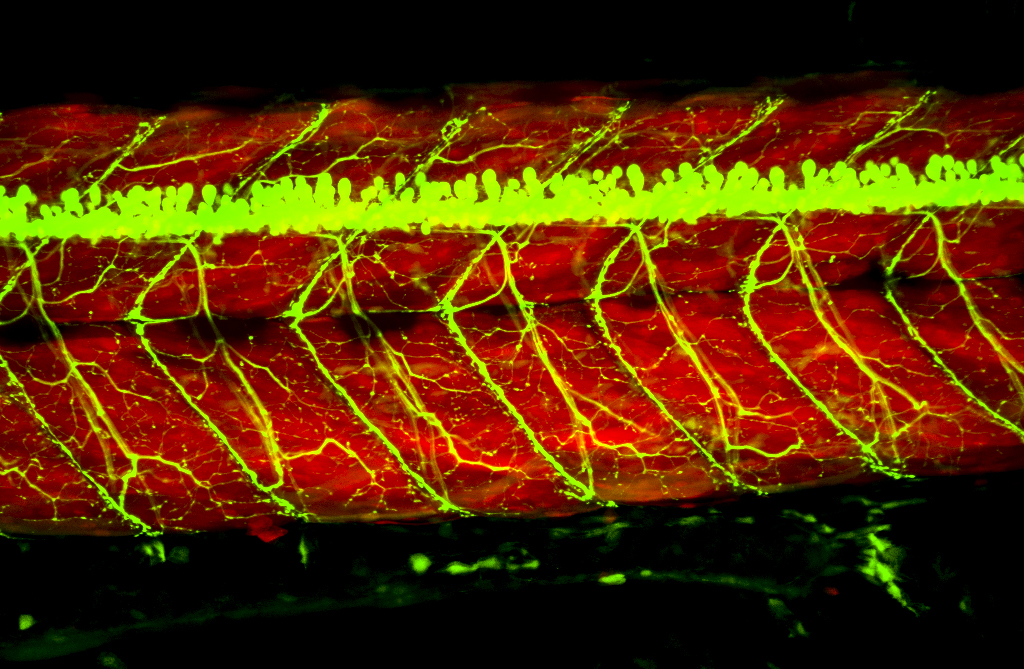Aquatic facilities & services
At a glance
- Facilities include both conventional and AA-compliant aquarium systems
- Comprehensive support including colony health, water quality monitoring, feeding, and equipment maintenance
- Conveniently located near surgical spaces, organoid facilities, microscopy and imaging equipment
- Specialist Aquatics technicians provide full-service support and 24-hour on-call facility care
- Training and technical services for basic husbandry and advanced procedures
Biological Resources Aquatics (BR-Aquatics) was established following the closure of the NHMRC-funded Australian Zebrafish Phenomics Facility (AZPF). Its purpose is to ensure UQ researchers continue to have access to high-quality infrastructure and support for aquatic model organism research. The division plays a vital role in advancing studies across developmental genetics, human disease, physiology, toxicology, and behavioural science.
With a total holding capacity of approximately 500,000 animals across multiple locations, BR-Aquatics supports large-scale research in zebrafish and other aquatic species. The facilities are purpose-designed to accommodate a wide range of disciplines—from disease modelling and developmental biology to cognitive studies and computational biology.
Standard support (included under the User Agreement):
- Life Support System (LSS) operation and equipment maintenance
- Larval nursery care and feeding
- Water quality monitoring
- Tank cleaning and colony health management
- Basic training in aquatic husbandry and facility use
Advanced services (available at direct cost):
- Microinjection
- In-vitro fertilisation
- Fin clipping
- Experimental setup and technical assistance


Prospective research groups
Please complete the online form, and we'll be in touch at our earliest availability. (To be updated).
Inductions
Bookings
Bookings - Microinjector (IMB access required).
Webdb
Live records for all Biological Resources Aquatics facilities are maintained in real-time within theWebDB database for animal ethics and regulatory compliance. Existing research groups can acess WebDB Instructions online.
Facility metrics
Current users can use the below facility information to report in enough detail facility information. Reporting animal research in adherence with the ARRIVE guidelines ensures transparent and thorough reporting. This enables readers and reviewers to scrutinise the research adequately, evaluate its methodical rigour, and reproduce the methods or findings. Research groups considering non-standard caging (opting out of a standard cage), should consider the following article to support understanding about indirect impacts to research design Reproducibility and Rigor in Animal-Based Research.
These documents cover housing, light cycle, water quality/exchange, feeding details to be used for publication references.
BR-Aquatics Facility Metrics 2023-2025. (PDF, 152.5 KB)
Health reports (Zebrafish focus)
- Pseudoloma neurophilia
- Microsporidia (unknown species, not notifiable risk)
Current Negative screening for:
- Edwardsiella ictaluri
- Pseudomonas aeruginosa
- Pseudocapillaria tomentosa
- Mycobacteria
- Chelonae
- Fortuitum
- Haemophilm
- Marinum
- Aeruginosa
- Lesser known species
BR-Aquatics Zebrafish OTTO and Seddon Health Report 2022 (PDF, 142.3 KB)
BR-Aquatics Zebrafish OTTO and Seddon Health Report 2023 (PDF, 162.2 KB)
BR-Aquatics Zebrafish OTTO and Seddon Health Report 2024 (PDF, 161.8 KB)
For other species reporting please contact us.
Operational documents
To view our local published procedures visit Operational documents.
To view our AEC approved SOP visit Animal Ethics SOPs > Other Laboratory Animals.
Pricing
The Biological Resources Aquatics facilities operate on an agistment direct cost recovery system. This system is divided into 3 main categories:
- Zebrafish Tank Agistment
- Xenopus Animal Agistment
- Exotics Tank/Animal Agistment
Agistment costs for an exotic model is variable and dependent on the animal, the animal's basic requirements and level of care, as well as the usage or acquisition of any special equipment.
Agistment costs are calculated based on direct use per tank / animal (as relevant to species / agistment list above), and cover housing, husbandry and standard operational costs (includes weekend care). Weekly usage is tallied and billed monthly, with costs able to be directed to particular group / shared funding as required.
Additional services outside of basic daily operations are billed as proportional cost per hour / unique consumable upon prior agreement.
See UQBR Agistment rates published here and to investiagte the applicable rate for your research group.
Contact us
- Team email - For enquiries or assistance for existing users email br-aquaticteam@uq.edu.au.
- Team administration - For inductions, prospective users, or ethics matter please email br-aquaticadmin@uq.edu.au.
- Phone - This is a direct line to reach the team, including for after-hours emergencies only on 07 3346 2164 (diverts to a mobile).
- UQBR Facility Manager - Gillian Lawrence g.lawrence1@uq.edu.au.
